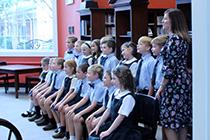Have you ever noticed how much easier it is to pour salt into your favorite shaker with a funnel? That great shape helps avoid spills—the grains just go with the flow. This simple tool makes kitchen tasks much easier to handle.
This little discovery reminded me of a “funnel” that changed my parenting game when my own three children were young. I originally learned this idea from Gary Ezzo, who taught it in a parenting course, one which afterwards became quite controversial. Yet this small parenting hack stuck with me, because it made my children happier and my life as a mom much easier.
It’s simply this: choices should be few when children are young and should broaden as they gain wisdom throughout their growing up years.
Let’s picture how this might play out with preschoolers at the dinner table. Imagine a home in which each child has a particular seat; no one chooses daily where (or whether!) they want to sit. There’s no pondering of color for plates or cups, or of what foods go on the plate. No one is learning to demand a certain placemat or cup. Thus, there are no arguments about who gets to sit by mom, or who uses the pink plate. No one is unhappy. The kids just go with the flow, having never been called upon to make choices about routine matters, and the meal can proceed in a peaceful way. The children actually feel more in control when their environment is predictable and everyday events such as meals happen within a rhythm—and with few choices to be made.
The benefits of this low-choice plan become even more clear when we consider the opposite. In that environment, children come to the table with ready-made opportunities to say “I want,” to contend for the seat they think is best or covet the cup that is “mine.” Disappointment and unhappiness are baked in. The parent’s effort to keep peace are defeated by an environment that provides too many choices, and conflict erupts. The wisdom of the book of James is confirmed by our own observations:
“What causes fights and quarrels among you?…You want something but don’t get it.” James 4:1-2.
Now, let’s play these low-choice vs. high choice scenes out again in a classroom setting. Imagine a child entering a wide-open room that features lots of toys, colorful displays, streamers hanging from the ceiling, and no direction as to where to go or what to do. Options are open! The room says, “Choose where you want to go and what you want to do.” Contrast that with children who enter a warmly decorated room with lots of books and age-appropriate desks in rows, facing displays at the front. Each child’s name is on a particular desk, and each knows just where to go. Much about what will happen in the space has been communicated by furniture and décor. This begins with a sense of belonging, the basic notion that he/she has a place to be and a direction to face. From there, the low-choice supportive environment elicits one response from students, while the open classroom conveys quite another message.
We tend to think that being able to choose one thing over another will make us happy, but current research (just Google it) as well as the wisdom of the Scriptures show us just the opposite. Too many choices weigh us down, provide disappointments when we can’t get what we want, and build a sense of entitlement when we do get the thing we choose.
Of course, even the youngest children have choices at school. There are times during the day when they can choose their own books, activities or seats. While we use the influence of an environment with limited choices to help young students feel confident and secure in the world, we also recognize the need to train them to make prudent decisions. As they progress through the grades at New Covenant, the funnel opens up with increasing levels of choice about daily schedules, the sports they will play, or the friends they will make. There is more unstructured time and personal freedom during the school day, and assignments can sometimes be chosen from a list of possible topics. Their ultimate project, the Senior Thesis, requires students to choose a topic and to live with it for many months, researching and constructing an argument from a variety of sources, also chosen by the student.
One final observation, just to encourage you to try limiting choices. I’ve noticed that children will argue about many things that seem small and silly, like which shirt they want to wear, or how their hair must be arranged on a particular day. In our pickup lines at school, I’ve noticed that students rarely argue about sitting in their car seats. That’s something they’ve never had a choice about. Because it’s critical for their safety, we never think of giving a choice, so they routinely jump in and buckle up. They just go with the flow. This approach works for the less important choices that can cause chaos on a daily basis, too.
Setting up an environment which supports fitting behavior in each situation is one way we as parents can set our children up for more than success in school and beyond. We can set them up to thrive with the support we give them by limiting choices when they are young.










































